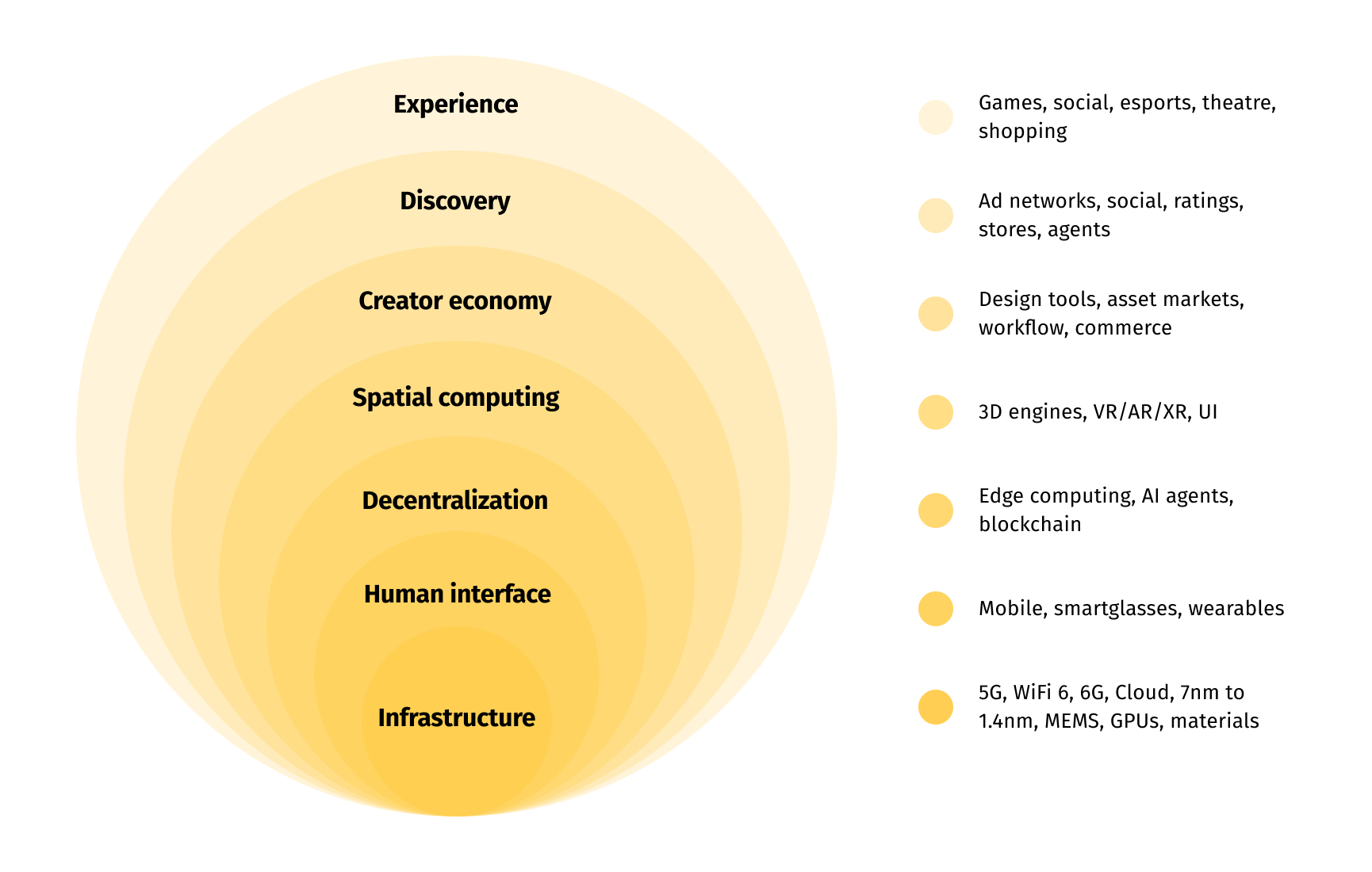
Into the future: embracing the metaverse
If you’re not thinking about the business impact of the metaverse yet, it’s high time to wake up and e-smell the digital coffee. Gartner predicts that by 2026, 25% of people will spend at least one hour per day working, shopping, studying, or using social media in the metaverse. Tech giants like Facebook and Apple are championing the development of the metaverse with the belief that someday everyone will work, play, and shop there. As technology continues to evolve, the metaverse has the potential to completely transform how we consume in the digital age.
What exactly is the metaverse and why is it worth the interest of everyone from office workers to business executives? Essentially, it promises to take the Internet to the next level by offering a fully-immersive and customizable platform that combines aspects of social media, online video games, and the apps we use in our everyday lives. The metaverse is the place where real and virtual worlds converge in the form of interactive communities and a functioning, real-time economy.
Let’s break down what the metaverse is, what it’s capable of, and what we can expect in the coming years.
What is the metaverse?
Imagine you’re working from home due to a family emergency but you have an important meeting back in the office. Whereas the COVID-19 pandemic gave rise to the Zoom meeting, a future with a full-fledged metaverse could allow a hologram version of yourself to sit in the boardroom alongside your colleagues. This is a fantastic but nonetheless viable example as to how the metaverse might reshape our work lives.
The term “metaverse” was first coined by the science fiction author Neil Stephenson in his 1992 novel Snow Crash, in which a pizza delivery guy lives as a supreme hacker in the virtual world. But what are we talking about when we refer to the metaverse today? The term regained popularity in 2021-2022 during the height of the COVID-19 pandemic. As the spread of the virus prompted nearly all spheres of life to embrace digitization, the metaverse became more than just a science fiction concept – it became the first step into the future of digital reality.
The metaverse is a decentralized, user-generated platform that draws from:
- virtual reality (VR), a computer-generated simulation of an environment that users can interact with;
- augmented reality (AR), a view of the physical world which is overlapped by computer-generated sensory, video, or graphic input; and
- mixed reality (MR), where digital and physical elements can interact.
- Admittedly, a fully-developed and unified metaverse is a long way off. Nobody is entirely sure what that will look like yet, but that’s what makes it so exciting. There is boundless potential and room for innovation. Leading tech and commercial companies are currently driving the discussion about how and to what extent the metaverse will shape not only our private lives but how we work, shop, socialize, go to the doctor, and so much more.
In the metaverse, each user is represented by their own avatar or character, and is accessible from your phone, PC, tablet, or any other device. It exists in real-time and is built around community interactions like any of the open worlds popularized in video games like Fortnite, but on a much larger scale. A fully-developed metaverse would allow users to earn and spend money in their preferred currency. Essentially, the metaverse would act as an extension of the physical world, allowing its users greater access to data.

How immersive will the metaverse be?
Pew Research Center recently asked 624 technology innovators, developers, business and policy leaders, researchers and activists about the potential of the metaverse in the coming decades. 56% of those surveyed expect that by 2040 the metaverse will be more developed and that it will be an immersive part of daily life for more than half a billion people globally.So what does this mean? According to experts, it is most likely that augmented and mixed reality approaches will define the metaverse in the coming years, rather than a full-fledged embrace of virtual reality like in science fiction novels. AR and MR driven by artificial intelligence (AI) systems can enhance daily life experiences by making communication and access to information not only faster and more convenient, but more enjoyable and compelling too.
Augmented reality already plays a role in our daily lives. Using AR, shoppers are able to try on makeup digitally or visualize how a couch might look in their home before even purchasing it. But AR has the potential to revolutionize more than just e-commerce. It’s already starting to have an impact in gaming, construction, education, healthcare, and a number of other fields.
As technologies continue to advance, technologies like AR will no doubt become further integrated into reality.
What will the metaverse look like?
As we’ve already established, the metaverse of popular imagination has yet to actually come into being. However, there are already several virtual worlds with a stake in what that future might look like; some are VR-based, while others run off a browser. They are disconnected and exist, for now, as separate virtual “worlds.” To the casual observer they might come across as nothing more than a video game but we know that the metaverse is intended to be fully-immersive. Many of these virtual worlds have established their own crypto currencies and sellable digital assets in the form of NFTs (non fungible tokens), with the intention of making every facet of consumer life accessible to its users.
There are promising technological advancements in AR/VR that are already revolutionizing industries such as retail and manufacturing. If we entertain the full potential of the metaverse, these industries will ideally be more data-driven and user-focused.
Retail
Fashion retailers were among the first to see the business potential in the metaverse. A number of major brands have already made investments in its current iteration, purchasing virtual plots of land in order to set up shop there. Essentially, retailers are endeavoring to create a more cohesive shopping experience in the metaverse. When users make retail purchases in the metaverse, they’ll be able to:- choose items from their favorite retail brands to be shipped to them at home;
- style their avatars to enrich their online experience; and
- “try on” clothes in 3D fitting rooms and get a 360-degree-view before making any purchases.
Retailers will also be able to track a customer’s purchasing and browsing histories, harnessing that data to offer more personalized item selection. Like the online shopping of old, customers will be able to access these virtual retail hubs whenever they want.
Manufacturing
Manufacturing in the metaverse allows for the creation of a “digital twin” where real-time data can be collected and used to gain insight on productivity, safety, external environments and numerous other factors. Ultimately, this will refine the decision making process and lead to increased safety and efficiency without cutting corners. By embracing AR/VR, manufacturers will be able to
- Offer quick and safe training to employees: first learning how to use heavy machinery in virtual reality instead of in real life is safer and more cost-effective, lowering the risks of accidents on the job;
- Create simulations prior to physical deployments: 3D, physics-based replicas of products can be produced in the metaverse and tested out in a number of virtual scenarios, reducing the margin of error;
- Repair equipment with the aid of AR/VR: field service workers can pinpoint anomalies and shutdowns no matter where in the world they’re located, bringing expertise to a global scale; and
- Promote worldwide collaboration: the Zoom meetings which came to define work life during the COVID-19 pandemic can be taken to the next level with meetings of the minds in virtual reality.
Embrace the metaverse today
If the COVID-19 pandemic taught us anything, it’s that we need to be ready for any extenuating circumstances, be it equipment failure, extreme weather conditions, geopolitical events, pandemics, or any other cause. Our day-to-day lives are increasingly moving online and industry leaders need to be in possession of the right tools to accommodate the massive amount of data that comes along with that shift. The metaverse has the potential to take online consumerism by creating a multifaceted and more accommodating virtual space for people to interact with one another.
Grid Dynamics has long stayed on top of the latest AR technology trends. Considering the role it plays in the metaverse, we’re looking forward to its potential and engaging with clients that want to harness technology to usher their business and clients into the future.
